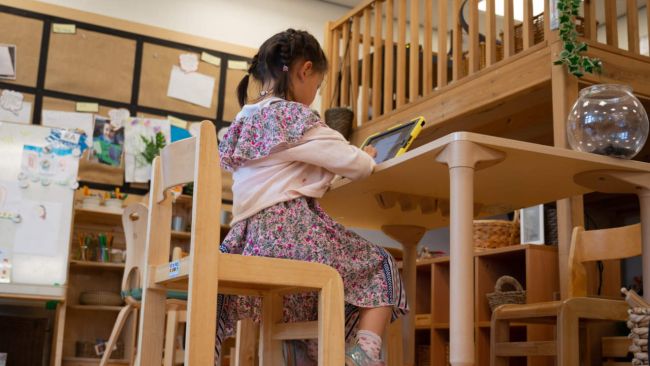How to Encourage Communication and Collaboration in Distance Learning
Using technology to create a more immersive teaching environment.

After a mad scramble to provide devices, broadband, and curriculum to students as schools suddenly closed in March for the remainder of the school year, educators are now focused on including more direct instruction and collaboration in their distance learning classes this fall. In many districts, while students are still learning from home, teachers are video streaming from their classrooms where they can access all of their teaching tools.
No one is happy about the dramatic increase in screen time that distance learning requires—not parents, teachers, or administrators. However, teachers are focused on creating lively lessons that engage and challenge students as if they were in the classroom full time. They want their instruction to be as effective as possible so that students can continue to progress toward their learning goals—even with the lack of in-person interaction.
In distance learning, it is critical that teachers are direct and explicit about the goals and expectations for each class, including student participation. Just as in the real classroom, teachers have to ensure that all students understand what is expected of them and manage the class so that every student is included. Teachers can encourage student questions and create discussion opportunities so that students connect with each other as well as with the teacher. This will build the trust and community that are necessary for effective learning.
One of the ways to make screen time more meaningful is to use available technology to create as dynamic an environment as possible. Video streaming is the best way to do this. Blending a mix of synchronous (live) and asynchronous (pre-recorded) lessons will help mix learning modalities so that students remain engaged. There is a new mobile interactive display that enables communication between teachers and students that is ideal for these days of distance learning.

Tripp Lite’s Mobile Interactive Display integrates a 65-inch 4K interactive touchscreen, a multi-user PC, a heavy-duty rolling stand, and a rechargeable lithium-ion battery system to provide an all-in-one presentation platform. The display is compatible with a wide array of applications and hardware, including Windows, Android, Chrome, iOS, and MacOS devices. A high-definition webcam and wireless networking provide clear communication between teachers and students. Access to a wall outlet is optional because the rechargeable battery system provides up to 90 minutes of power.
Remote screen sharing and user-friendly tools encourage collaboration and problem solving – two of the highly valued skills for college and career success. The ability to interact with students, outline lessons, and organize information simultaneously makes this mobile display superior to any electronic whiteboard. Interactivity is supported by 20 points of multi-touch to accommodate multiple users. The detachable 1080p webcam with a wide-angle view captures the entire classroom and screen sharing increases the opportunities for student engagement. Keeping students engaged is one of the best indicators of impactful learning.
It is unclear how long schools will be teaching via distance learning. Many educators believe that a hybrid model of in-person and online classes is likely to last beyond the end of COVID-19. There are certainly best practices for this combination of instruction and learning modalities, including video streaming to create the most immersive experience possible. Helping students remain engaged fosters communication, collaboration, and problem solving skills – critical elements in students’ tool kits for a successful future.
Click here for more information on the Tripp Lite Mobile Interactive Display.
Tools and ideas to transform education. Sign up below.
